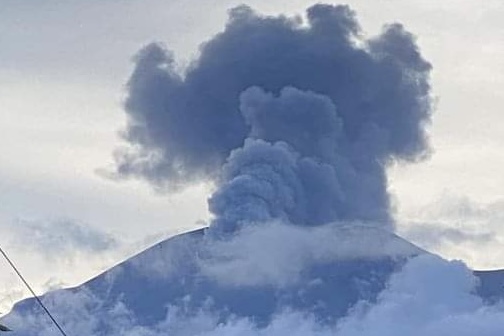Increased volcanic ash emission events at Kanlaon Volcano in Negros Island have been reported, according to a 10:30 a.m. advisory issued by the Philippine Institute of Volcanology and Seismology (PHIVOLCS) on Saturday, November 9, 2024.
"Since October 19, 2024, continuous degassing with occasional weak ash emission has been occurring from the summit crater of Kanlaon Volcano," the advisory reads.
"Visual monitors of the Kanlaon Volcano Network (KVN) have recorded twenty-eight (28) ash emission episodes that lasted four minutes to one hour and eighteen (18) minutes and generated grayish plumes that rose 300 to 800 meters above the summit before drifting to the general west," it added.
Further, PHIVOLCS said that the ash emission has been generally “quiet” and occurred without seismic or infrasound signals. The latest episode occurred morning of November 9, 2024 between 5:46 a.m. to 7:02 a.m. and persisted for one hour and 16 (sixteen) minutes based on visual observations.
"The event generated light-gray plumes that rose 750 meters above the crater before drifting southwest. Traces of ash were reported in Sitio Bais, Barangay Yubo, La Carlota City and Barangay Sag-ang, La Castellana," PHIVOLCS added.
Sulfurous fumes were also experienced in Barangay Yubo and Barangay Sag-ang. In addition, microscopic examination of ash samples from October 19, 2024, and November 2 and 5, 2024 events revealed an "ash composition of mainly pulverized old rock within the edifice and not of material from new magma," the advisory further stated.
It was also learned that volcanic SO2 emission from the summit crater of Kanlaon based on campaign Flyspec measurements on November 8, 2024, averaged 4,701 tons per day.
Kanlaon has been persistently degassing high concentrations of volcanic SO2 with a current average rate of 4,299 tons per day since the phreatic eruption on June 3, 2024.
PHIVOLCS reminds the public that Alert Level 2 (increasing unrest) prevails over Kanlaon, but that current activity at the summit crater may lead to eruptive unrest and an increase in the Alert Level.
"The public is strongly advised to be ready and vigilant, and to avoid entry into the four (4) kilometer-radius Permanent Danger Zone (PDZ) to minimize risks from volcanic hazards such as pyroclastic density currents, ballistic projectiles, rockfall and others," PHIVOLCS further said.



